-
Marketing Objectives: Alignment to the Organization
Welcome back readers! This week I’ll be discussing one of the most useful concepts that marketers rely on in their everyday roles. This concept is none other than marketing objectives. When performing our tasks for clients and our companies, it is extremely important to have these objectives so that there is a sense of direction and purpose. This allows us to ultimately reach our marketing goals in the most successful way. There’s a lot to cover when talking about marketing objectives, so lets dive right in starting with different types and frames of objectives.

There are multiple different directions marketing campaigns can take. As shown above, there are three categories often employed by marketers and are categorized as awareness, consideration, and conversion. Under these three areas are more specific objectives such as brand awareness, app installs, and store visits. It is important to note that a campaign can take on multiple of these objectives or just one. Defining what they are though is crucial because we then tailor all marketing activities to meet that criteria. If you work at an agency like I do, these objectives will change more often due to the diverse needs of different clients. At a large company like PepsiCo with a solid in-house marketing force, these goals can be different for their various products, but objectives are often less diverse due to the company sticking with set objectives over a longer period of time.
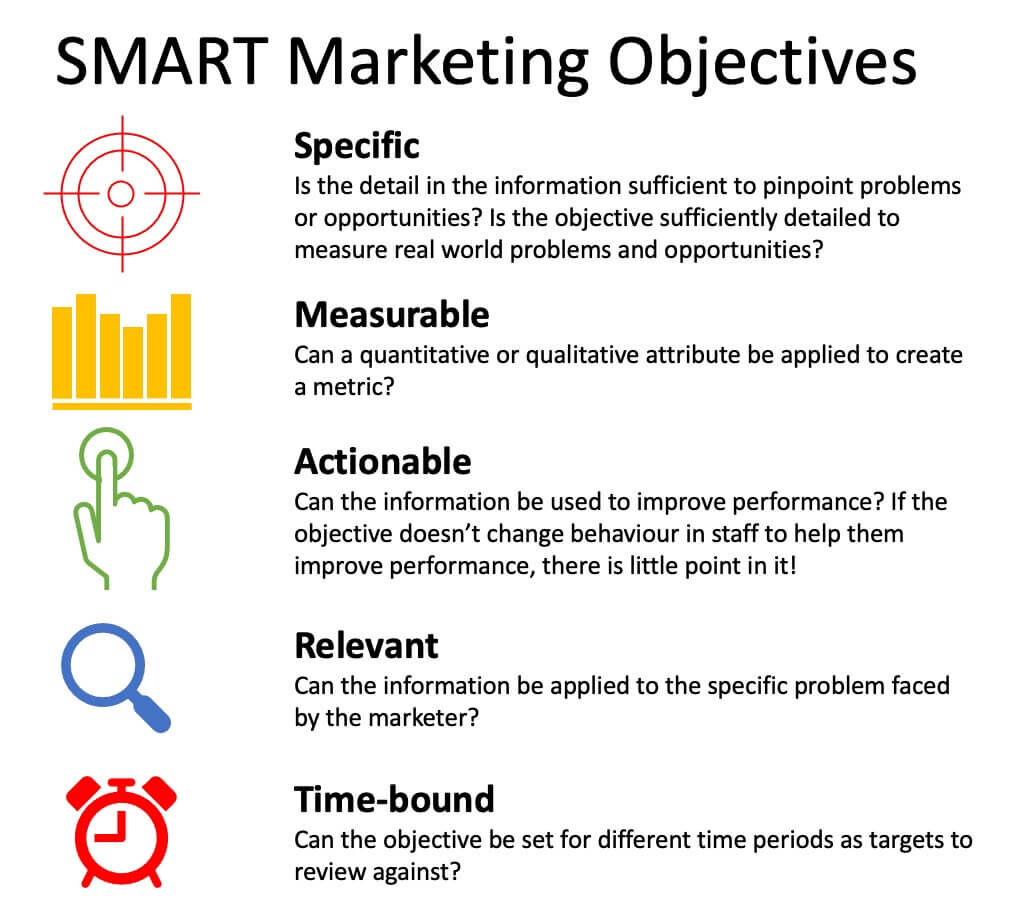
Another way to look at marketing objectives is through the SMART framework. As shown above, this framework incorporates five key areas to obtain your marketing objective. Those areas are specific, measurable, actionable, relevant, and time-bound. There are two ways in which markets use this framework and both ways lead to enhanced marketing objectives. The first way is by using the SMART framework to create the initial objectives for the campaign or marketing activity. The second way is to use it to test out different objectives against the criteria of SMART. In the second method, this allows us to adjust previous campaigns or objectives and improve them.
Now that we know some of the ways marketing objectives are created, let’s talk about how they are relevant. Marketing objectives aren’t just created with frameworks or methods, but are created with relevance to many aspects of companies. These aspects often include a company’s overarching mission/values, objectives, and goals. I mentioned PepsiCo before as it just so happened to come to mind, but their mission has been immensely influential in their marketing. PepsiCo’s mission is to create more smiles with every sip and every bite (PepsiCo, 2022). We can easily digest that their mission is about creating a positive and fun experience in the world of food and beverages for consumers. One of their recent big campaigns was the Lays Smile campaign that featured smiling faces on their potato chip bags and it generated a ton of positive social media buzz. Marketing with the concept of aligning objectives to the core of the company’s mission and other areas is an extremely valuable approach that creates a stronger link in branding in the consumer’s mind. That is the benefit marketers are after when they create these marketing objectives and I can’t stress enough how important this is for all companies to employ.
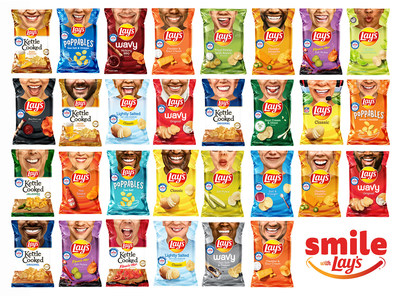
Lays Smile Campaign One last last piece of the puzzle to keep in mind during marketing objective activities is legal and ethical concerns. Of course we want to market our products as the best and talk about the amazing features , but deceptive and misleading information can lead to a world of trouble for yourself and the company. Just make sure to keep all the requirements and laws in mind when creating objectives, and that will help prevent you from creating problems in the rest of the activities.
References:
PepsiCo. (2022). Mission & Vision Winning with PepsiCo Positive (pep+). PepsiCo. https://www.pepsico.com/who-we-are/mission-and-vision#:~:text=Our%20mission%3A%20Create%20more%20smiles%20with%20every%20sip%20and%20every%20bite&text=By%20creating%20joyful%20moments%20through,products%20and%20unique%20brand%20experiences.
-
Market Segmentation: Key Tools
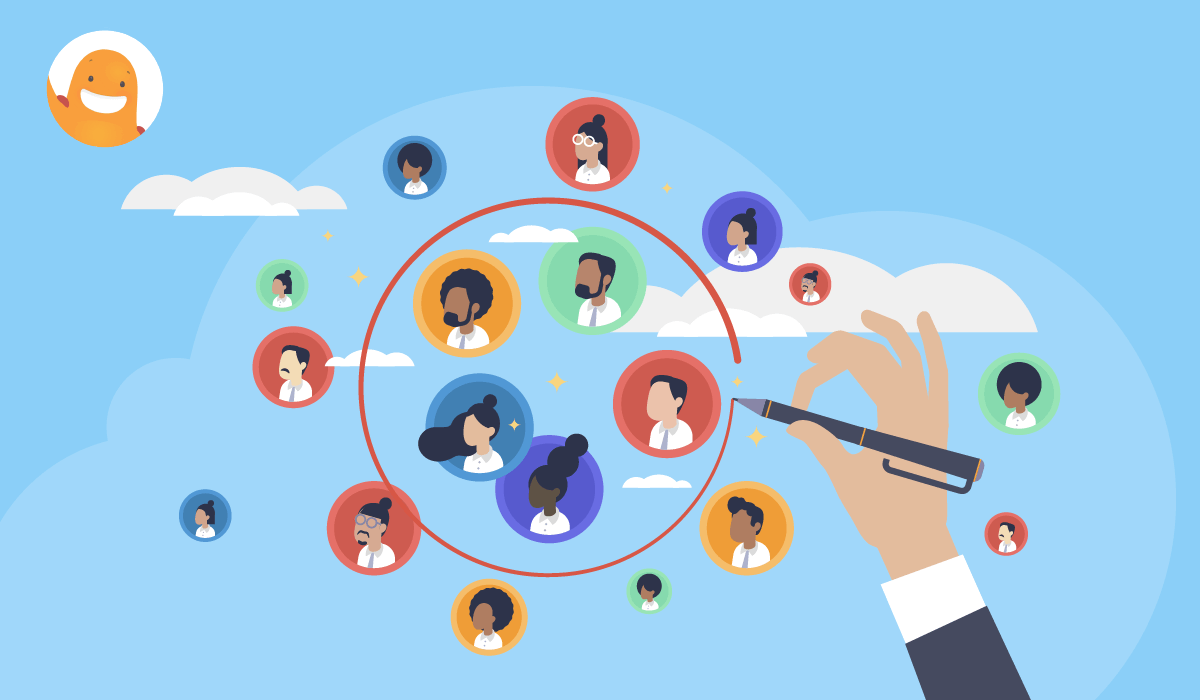
Welcome back to the blog everyone. I hope you’re having an awesome week! For this blog, I’ll be discussing some key tools that marketers use to establish segmentation for products and branding. Just to get things started, lets start with a definition for our topic. Market segmentation is the idea of aggregating prospective buyers/customers into groups or segments with common needs and who respond similarly to a marketing action (Tarver, 2022). Now that we understand the topic, it is also important to note the basis upon which most segmentation strategies draw from. Below are four core categories along with the specifics of those categories which many tools in segmentation use.
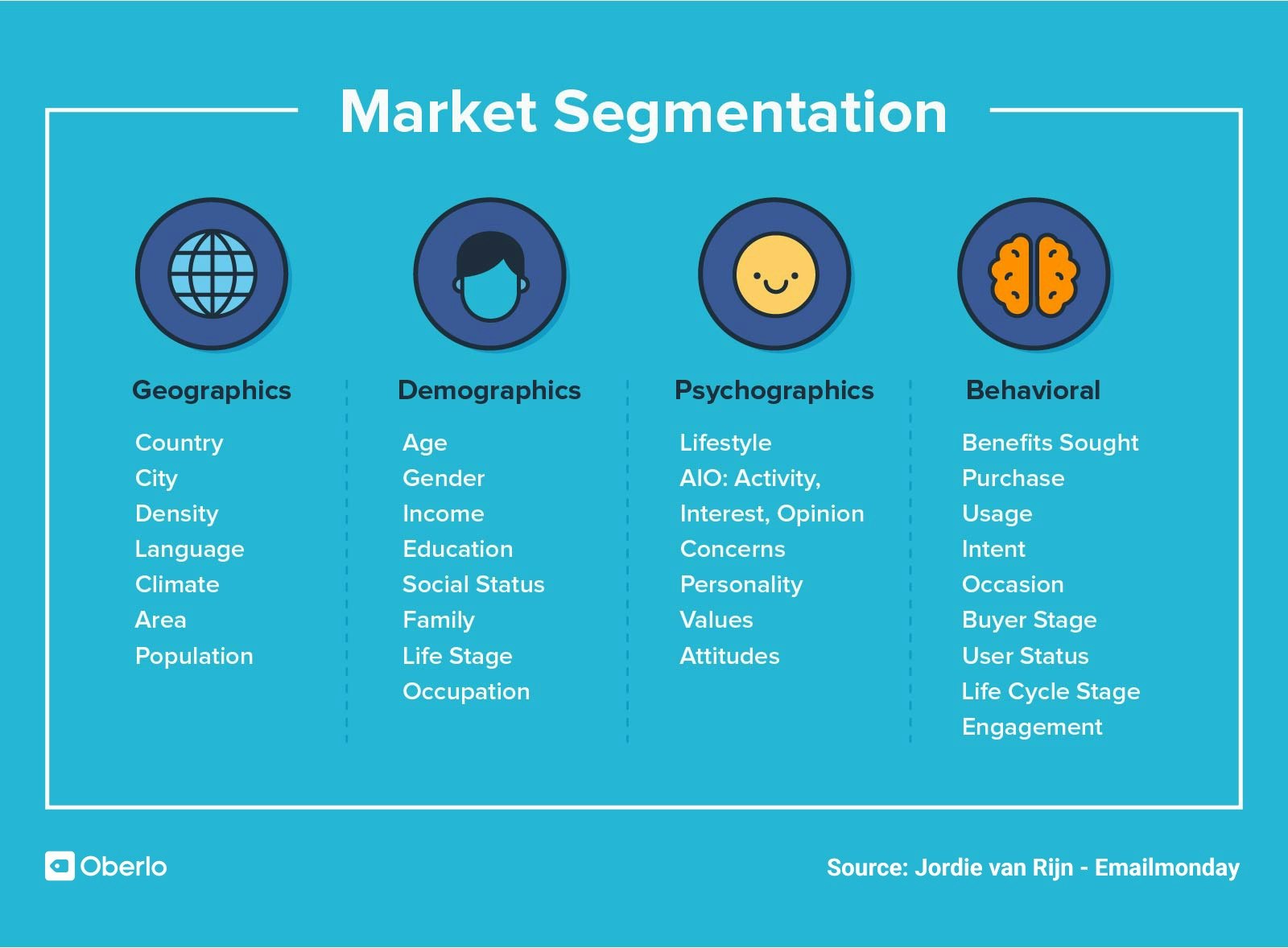
With our introductory and background now discussed, lets discuss the first tool which is the VALS framework. This framework is aimed at segmenting people in a more specific way, and determines different classes of people who have varying values, attitudes, and lifestyles (Bhasin, 2020). The way this is achieved is though having individuals take a specifically designed survey, and then given a VALS type. This is the segmentation from which marketers use to achieve their goals for a campaign. The framework consists of eight types and is combined with the concepts of consumer primary motivation and available resources. See below for a look at the framework.
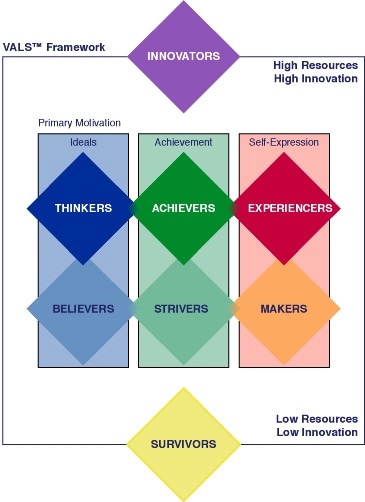
The second tool I’ll be discussing is Google Analytics. This powerful tool created by Google is data analytics. Within this online platform of Google, this tool is used to break down aggregate data by different dimensions (e.g. age, gender, income, location, etc.) to identify patterns (e.g. clusters of customers with similar characteristics) (Han, 2017). Essentially this tool allows businesses and marketers to breeze through significant amounts of data and establish segments. Within establishing those segments, the company can find one that fits their product or brand. As you may have noticed, this is segmentation at it’s core and relates back to segments I described earlier. With multiple tools and models such as Google Analytics and the VALS framework, companies can accomplish their segmentation and marketing goals.
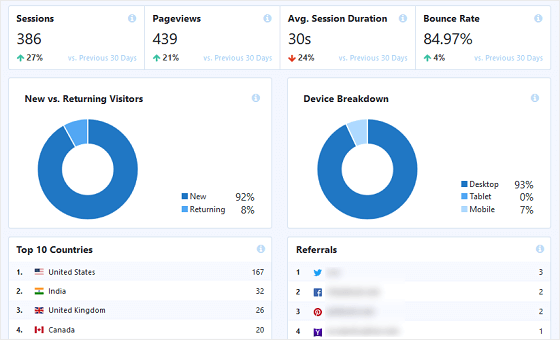
References:
Bhasin, H. (2020, January 30). Vals – Values attitude lifestyle. Marketing91. https://www.marketing91.com/vals-values-attitude-lifestyle/
Han, P. (2017, September 13). How to Use Customer Segmentation in Google Analytics to Build Your Buyer Persona. Medium. https://medium.com/analytics-for-humans/how-to-use-customer-segmentation-in-google-analytics-to-build-your-buyer-persona-8b464e130336
Tarver, E. (2022, July 25). Market Segmentation: Definition, Example, Types, Benefits. Investopedia. https://www.investopedia.com/terms/m/marketsegmentation.asp
-
Starbucks: A New Strategy

Welcome back to my blog readers, and I hope you are all having a wonderful day! This week, I have something that many of us can’t live without. Of course, I’m talking about coffee. In particular, I’ll be talking about a new strategy for Starbucks that I believe will help them grow and keep them from losing market share to new competition. I’ll give you a hint about the strategy to see if you can guess it. Dutch Bros, a growing competitor has to do with the new strategy. Before we get to the strategy though, lets run though a little bit more about the Starbucks as a business.
When we think about Starbucks, a fresh cup of coffee served up at one of their beautiful stores is the first thing that comes to mind. While this is certainly a huge portion of their business, there are many more key items that make up Starbucks. They serve other popular drinks like tea, refreshers, and hot chocolate. Food such as desserts and breakfast items also make up a portion of their sales as well. K-cups and pre-packaged coffee beans are one of the last pieces of the puzzle that make up Starbucks. The value Starbucks brings to their customers are quality products, convenience, and excellent customer service. All of these factors are a key component of why this new strategy will make sense. The last area to look at is profitability. The company is extremely profitable in terms of all their revenue but for this strategy, we want to look at Starbucks in just North America. When analyzing profitability in North America, Starbucks is doing great with. Their net revenue grew by 13% from $5,370.5 million in Q3 FY21 to $6,058.4 million in Q3 FY22 (Starbucks, 2022).

Starbucks SWOT Analysis (MarketLine, 2022). Starbucks has a lot of main strengths that align with the proposed new strategy. The first area of alignment is their strength of value added services and how that creates a strong connection with customers (MarketLine, 2022). If Starbucks is all about valued added services, then adding more valuable services that meets people’s wants and needs is a great proposition. Another strength that aligns well with this costly idea is their high liquidity position and ability to execute this plan financially. The last thing any company wants when making strong changes or adding services/products is to not have the financials to finish or maximize the idea. Lastly, their operational network position puts them in place where growth is less likely to be obtainable and logical. If this new idea causes rapid growth, the company won’t be slowed down by operations and getting the resources they need which can be a major threat to growth for any company.
Everything mentioned will all come together now that I’m revealing the new strategy. This new strategy is the addition of drive-thru only Starbucks stores. Some of you may have guessed this from my mentioning of Dutch Bros in the beginning of this blog. Dutch Bros has found massive success with this model as it is their own store model. It’s important to note that while people really value the luxurious space of Starbucks stores and the in person experience, the ability to increase the number of Starbucks locations is beneficial to the consumer. This new type of building has decreased costs and need much less space when compared to their current buildings. While this idea isn’t truly unique due to a couple other companies currently using it, it is new for the company and is becoming very popular with coffee lovers due to it’s convenience.
When looking at all the factors above, I believe it becomes apparent that figuring out this additional store structure model can increase profitability for Starbucks. With the combination of the original stores and these new stores, Starbuck’s will be better able to serve their customers whether they want that in person experience they already love with the company, or if they are strapped for time and need a cup of coffee quickly. Ultimately this idea is giving Starbucks the ability to expand into new locations across North America and solves a problem in the market that is faster and convenient service.
References:
MarketLine. (2022, August 26). Starbucks Corp. MarketLine. https://advantage-marketline-com.ezproxy.snhu.edu/Company/Profile/starbucks_corporation?swot
Starbucks. (2022, August 2). Starbucks Reports Q3 Fiscal 2022 Results. Starbucks. https://investor.starbucks.com/press-releases/financial-releases/press-release-details/2022/Starbucks-Reports-Q3-Fiscal-2022-Results/default.aspx#:~:text=Net%20revenues%20for%20the%20North,months%20and%20strength%20in%20our -
Ethical Dilemmas & Volkswagen

Welcome back to my weekly blogpost. Today’s topic will be all about ethics and branding. Specifically I’ll be discussing how Volkswagen was hurt due to poor decisions and how this affected their brand in various ways. Although I’ve never owned a Volkswagen, we all know of the brand and most likely have heard about their major issue a few years back.
Let’s start with what happened. Volkswagen confessed to cheating emissions tests on 11 million of their vehicles across the world in 2015 (Toebe, 2020). In a growing world of environmental concern, this is a major dilemma as they were basically saying their cars were putting out less pollution in the form of emissions then they really were. A couple thousand cars might be a different story, but the sheer volume they lied about, resulted in severe lash back from the media and consumers. Not only did the brand face a tarnished reputation, but they paid fines of $9.5 billion to American car owners, and $35 billion internationally (Toebe, 2020). The scandal ended up costing Volkswagen severely in their brand rating. Before the scandal, their brand was ranked as the worlds 18th most valuable brand, and it took them five years to reach back to the 25th spot for BrandFinance’s annual rating (Colvin, 2020). It’s safe to say consumers were not happy with the brand as they are even seen protesting below.

Fig 1 When it comes to ethical dilemmas this large, there’s a lot to consider when discussing what they could have done better. Unfortunately, I believe this one of those scenarios where the cars were so far along in the process that getting them all back and doing the right thing by the company to fix the issue would have outweighed the penalties they paid and they made that calculation. Doing the right thing would have of course been the correct course of action. Due to ideas such as letting this scandal occur are possible for companies, there needs to be solutions to stop this. One idea is to increase laws on the matter and the laws regarding that of whistleblowers at companies. I’m sure many people wanted to speak up, but most people fear losing their job because of incidents like the GM whistleblower Bill McAleer who lost his job in 2004 (Heffernan, 2015). The other solution is to increase ethical training and compliance culture. This should have been done at a much earlier stage for the massive company, but as of 2020, Volkswagen has been working on this and a whistleblower program (Sun, 2020). All in all there’s a lot to learn about ethics from this situation, and as an environmentally conscious person, I hope no car manufacturer ever lets this happen again.
References:
Colvin, G. (2020, October 6). 5 years in, damages from the VW emissions cheating scandal are still rolling it. Fortune. https://fortune.com/2020/10/06/volkswagen-vw-emissions-scandal-damages/
Heffernan, M. (2015, September 22). The Volkswagen Scandal Was Entirely Preventable. Here’s How. Observer. https://observer.com/2015/09/killer-instinct-how-ceos-can-prevent-mistakes-that-put-them-in-jail/
Fig 1. Schreiber, Y. (2019, September 14). Protests against German car industry rev up in Frankfurt (Update). PHYS ORG. https://phys.org/news/2019-09-protests-german-car-industry-rev.html
Sun, M. (2020, September 30). Volkswagen Tries to Change Workplace Culture That Fueled Emissions Scandal. The Wall Street Journal. https://www.wsj.com/articles/volkswagen-tries-to-change-workplace-culture-that-fueled-emissions-scandal-11601425486
Toebe, M. (2020, September 11). Critical Lessons from the Volkswagen Scandal. CCI. https://www.corporatecomplianceinsights.com/lessons-volkswagen-scandal-ethical-failings/
-
Brand Positioning Importance: Nike
Welcome back readers! This week I’ll be sharing some lessons from Nike in the realm of brand positioning. We will examine this topic through Nike’s logo, slogan, and company name. As many of you may know from my lifestyle blogs, I am a big fan of Nike so this was a fun one for me to write.
Now that we gave a little broad background on Nike’s branding, lets focus on the first topic which is their logo. The idea behind the logo is that one of the founders was looking for a logo that encouraged or represented movement. The iconic swoosh that we all know was the answer to that. The swoosh was also inspired by the wings of the Greek goddess Nike. That aspect of the logo is more of just a fun fact, but the first idea is monumental. The idea that this logo was created to represent the entire basis of movement and it relation to sports makes it extremely brilliant. In my opinion this is Nike’s strongest branding tool and it is one of most instantly recognizable logos world wide.
Now, lets dive in. I wanted to start by also sharing the brand’s mission and vision. Nike’s mission is to bring inspiration and motivation to every athlete in the world (Nike, 2022). Moving onto their vision, Nike sees a world where everyone is an athlete unite in the joy of movement (Comparably, 2022). Both of these brand statements are bold and powerful. They are crafted to communicate the idea that the brand represents that everyone is an athlete and therefore fits in with their brand. As far as success, these statements are a complete success.
Another iconic brand piece for Nike is their slogan “Just do it”. So what is it about this slogan that has made it so influential. Well, it communicates the essence of the brand perfectly. It does this by inspiring people to take an action. That action can be anything, but doing something athletic no matter what it is, is what the brand is all about. A fun fact about the slogan is that it was actually created by an ad agency in 1988 and was inspired by the last words of a man on death row that said “lets do it” (Bostock, 2019).
The last piece to this puzzle is the company name. While names of company’s don’t have to have a deeper meaning, Nike’s does have some interesting branding behind it. Their name is basically inspired by the Greek goddess Nike I mentioned earlier and she represents victor and strength. As you can probably see by now, this again aligns with Nike’s branding and really ties all of the aspects discussed today together. Continuing on the Nike example, there are some general lessons in naming especially that we can transfer to new businesses. The first strategy I observed here is keeping the name to a single word, or as short as possible. When examing some of the most powerful companies in the world, you’ll notice a huge proportion are single words. This is because of how powerful one word can be and it makes it easier in many aspects for the business and consumers. The other strategy is to have some meaning behind the word that actually adds something to your brand or communicates the branding further. For all these reasons though, Nike is nothing short of brilliant with their branding position and this is what makes them one of the most powerful companies in the world.
Before I let you go, I just wanted to thanks my readers, and I hope you have an awesome week or weekend.
References:
Bostock, B. (2019, August 10). The sinister story of Nike’s ‘Just Do It’ slogan, which was inspired by the last words of a murderer before he was executed. Business Insider. https://www.businessinsider.com/nike-just-do-it-inspired-utah-killer-gary-gilmore-2019-7
Comparably. (2022). Nike Mission, Vision & Values. Comparably. https://www.comparably.com/companies/nike/mission
Nike. (2022). Our Mission. Nike. https://about.nike.com/
-
Under Armor: Marketing Segmentation Insight
What’s the first thing that comes to mind when when you think of the company Under Armor? For me, I think of athletic apparel and equipment, and I think back to my high school sports days playing football in the cold, but surviving because of my under armor. As a daily exercise participant, I’m definitely part of Under Armor’s target market. Today I want to talk about a specific campaign and segmentation for the company though. This campaign is the “I Will What I Want” campaign, which was a huge success for the company.
In this campaign, the core focus was on segmentation through demographic characteristics. The demographic characteristic that was target was women. Not only is this a huge demographic to target, but information is easily available making it easier to market to the demographic. Another piece of segmentation identified in the campaign is psychographics. The campaign aimed at invoking a response of resonating with the demographic’s lifestyle, attitudes, and beliefs. So, how was this accomplished in the campaign? Well, the strategy that Under Armor used in this was using a couple key female athletes. The first athlete was a successful and renowned ballerina that was shown in the ad facing criticism at the age of 13 for having the incorrect body for ballet. The second athlete was a famous model that was shown in the ad participating in boxing and receiving both and praise backlash for trying to box.
While I believe this campaign was a huge success and brilliant in many regards, I’m going to share some key points to always remember when implementing segmentation strategies in your business or place of work.
- Consumers preferences vary.
- Tailoring products or services to consumer’s needs makes that offering more appealing to the segment and therefore will encourage them to pay a higher price.
- Market segmentation increases sales and cost simultaneously.
- Beware of cannibalization
- Small or narrow segments can be better than focusing on broad or large segments
With those key points in mind, lets talk about possible new routes for Under Armor to take in regards to marketing and segmentation. After seeing some ads for new home gym equipment, I believe this is a new segment for the company to approach. This new market would be segmented by the psychographic of lifestyle, age and possibly a couple other factors. The ideal person to fit the segment would be of any gender aged 21-45 that likes to workout at home. The strategy I would employ for this market would be through the use of humor in ads that show people going from work to the gym by walking from one room in their house to the next and instantly swapping clothes. In this new marketing campaign I’d roll out new Under Armor Equipment in the form of such items like weights and machines. With research into the segmentation and a solid execution of the strategy, this can only be a huge success. Right?
-
Consumer Type: Me
Whether you’re an avid shopper or someone that isn’t that into shopping, it’s inevitable that we are all consumers. Personally, I love shopping. I think many people prefer online shopping over making in-person purchases, but I enjoy both, with slightly more enjoyment coming from online shopping. When looking at breaking down consumers, there’s a lot of areas to cover. One area of consumers is by type. There are two types of consumers which are individual consumers and organizational consumers. Unless it is for your job or business, you and I are both individual consumers.
Now that we know the type of consumer I am, it’s time to discuss what influences my buying decisions and how. Some decisions are easier and some take time. Some examples can be seen in grocery shopping. Grocery shopping is relatively fast when it comes to decision making time and I usually buy brands that I know have satisfied me and brands that I like. Part of this like for those brands come from that positive experience I’ve had with them or possibly the company’s marketing or a combination of both. A different example for me in regards to decision time is buying a car or maybe a computer. Both of the purchases I’ve made in those categories required diligent research and sometimes months before actually making a purchase. I believe as you read this you might find that we are similar in our purchasing when it comes to the examples given.
Within the purchasing of goods, there are stages that lead up to the actual purchase. The stage that actually leads to me making a purchase is the final evaluation phase. This is the phase that is closet to the actual purchase and is crucial for me before buying anything. During this phase I think about necessities, and whether or not this purchase is going to help me with something. If it’s food, I’m thinking about having a rounded diet. If it’s a vehicle, I’m thinking about how this car will solve many current problems regarding my current vehicle. This phase also combines a lot of previous phases into one phase as I’m really going over everything that led me up to this point of almost making a purchase.
I think as a marketing major, I’ve become much more aware of just home much I’m influenced by marketing elements when it comes to purchases. Certain celebrities and influencers that promote a product I’m already interested in will help solidify that purchase for me. Any kind of marketing with humor also resonates with me a lot and I might even buy something I normally wouldn’t have if it wasn’t for their genius marketing. From insurance to headphones, advertising has definitely played a major roll in the purchases that I make.
The last point I want to touch on is post-purchase behavior. What this really means is how do I feel or act after making a purchase. A recent large purchase I made was buying a new laptop. As you expected, this took me months of research and deal shopping, but I wanted it for so long, and after hitting that purchase button, I was filled with joy instantly. Companies know about this aspect of consumer behavior of course, and they sent me a congratulations email. This email was to add on to my post-purchase behavior, and it most certainly did just that. Other purchases can lead me feeling with negative feelings though. One example that is very relevant to everyone right now is purchasing gas for your car. Gas is extremely high in price right now, and after I’m done filling up and see the cost, I’m instantly hit with negative emotions.
-
Marketing Perspective: Influencers
For today’s blog, I wanted talk about about the fascinating world of influencers and their effects on the marketing world. Some notable influencers I follow are Dave Portnoy, Tom Brady, Mark Normand, and Rich Rosales. You might be asking how is Tom Brady an influencer, but just because he is a sports legend, doesn’t mean he isn’t on social media acting as an influencer with his accounts and content. An influencer can be anyone in today’s world such as comedians, sketch comedy, dancers, cooks, gamers, and already famous people.
The first thing I notice about this type of advertising is that it has become wildly successful in such a short amount of time. Ads were acted out by very specific people and it seemed like a small club to be apart of the advertising world. The rise of social media and influencers has given way to people from all sorts of backgrounds and specialties to bring value to companies seeking to advertise through them. This opens the doors to reaching more people then ever before and being able to analyze and strategize how to use each influencer to market products or services.
The strategies we can see with marketing done by influencers is that the success has come from incorporating the marketing into what works for each influencer. If someone does comedy sketches, then the marketing is worked into how their normal videos play out. There is the side of this marketing where they are just doing old fashioned and tailored advertisements, but consumers are more aware and skeptical of this today. The idea of working the advertising into the natural flow of the content is the highest and best use here because it feels more genuine and less like an ad.
The role that these influencers play in marketing is to be a face for the product and to reach their followers/potential content viewers. Not only do they act like a mini spokesman for the company, but they become a part of the branding the company aims to employ. Their job is to promote the products or services in a way that doesn’t bore the consumer and in turn makes advertising more fun. Additionally, companies can segment their advertising into deeper analytical aspects by researching an influencers followers and advertising through specific ones to maximize marketing efforts.
Through the use of this new marketing perspective, it’s apparent that it effects the relationship between the consumer and the company. This newer area of advertising lets companies connect further with consumers. Answer me this, if you’re just doing advertising through traditional tv what are you options for reaching the right consumers? The answer is basically just picking a channel and using the demographics of the people that watch the channel as a means to connect with your ad. With this new marketing, the same idea can be noticed, but their are a million more specific channels and influencers to tap into and the connection can be increased ten fold.
References:
CBS Interactive. (2016, October 23). The Influencers. CBS News. Retrieved February 12, 2022, from https://www.cbsnews.com/news/60-minutes-kim-kardashian-logan-paul-social-media-influencers/ -
4-2 Blog: Effectively Impacting the Consumer Through Digital Media
I can’t be the only one that has ever lost an item at the airport. Whether it’s our luggage being mishandled, or forgetting our wallet while waiting for a flight, people lose things everyday at airports around the world. Many airports have a not so great reputation when it comes to this or any other aspect dealing with customer service. Tampa International Airport took an opportunity of a lost stuffed animal tiger to show how their airport is different and more caring than the industry’s standards. The tiger was brought all around the airport campus and spent time with workers before making it back home to it’s owner. This act and advertising through this is a great display of the meeting the needs of their customers. Sharing the pictures from this stuffed toy’s adventures went viral and delivered to consumers the overarching concept of customer service and care at their airport.
The social and consumer experience was addressed through social media posts documenting this story. The pictures they used used highlight the level of care the employees took on this matter. This event not only gives consumers relief when traveling through their airport, but lets the consumer know how dedicated and caring all of the employees there are. Having an airport staff that cares about it’s travelers is a huge selling point, and one that the industry struggles with.
Digital media followers were handled extremely well by the airline in a number of ways. They did their best to make this story as shareable as possible. The Twitter and Facebook posts were linked back to the full story on their website for starters. Secondly, they had followers all over their social media sharing other stories of their airport in which they cared for their consumers in various different situations. The airline made sure to share other’s stories. They also responded to people’s comments on their original posts, and responded and shared the stories that followers posted.
This experience and story is almost near perfect. Without taking away from the airlines amazing actions and the story here, there is one way this whole situation could have been enhanced. The use of video in addition to pictures would have made for even more content to use to spread this story too all consumers. Video is always an additional enhancement to a story that is just told through pictures or words and I think the fun the airline had during this stuffed animal’s journey would have connected on a deeper level with consumers.
Before I go, lets just take a look at the airports social media and other digital media. It seems the airline’s favorite and most frequent social media presence is through twitter. Here there post a lot of travel related information, weather information, and hilarious memes. When looking through the rest of their social media, the overarching theme remains the same and their branding is aimed at being relatable which I find humor to be a perfect way to achieve this. All of their posts remain within ethical standards, and there is no oversaturation of them bombarding followers to use their service which adds value to the their followers. Their app is very outdated, but it gets the job done with being another tool that I’m sure frequent fliers through their airport find adds value. The app is basic in the sense that it really just shows all flight times and information, but also has some other stuff like show and food maps.
-
Branding: A Day in the Life
When it comes to digital media, I consume a lot on a daily basis. Whether it is for work, connecting with friends, or for my own enjoyment, digital media plays a role in all of those aspects of my life. For work, I tend to use Zillow, and other home searching sites when doing various activities for my clients, and I use Facebook for digital advertising. Of course, my most prevalent form of communication for work is through Gmail. For connecting with friends, Snapchat is my go to. My personal life tends to see a wide variety of digital content including TikTok, Netflix, Reddit, and YouTube.
Any form digital media can be positive and negative. One user can have good experiences while another user has bad experiences with the same media. With that said, I find to have a majority of positive experiences with digital media. The digital media I use for work is there to add more tools which ultimately makes me perform better. Rather than simply texting or calling, Snapchat lets my social life be more than that with sending funny videos or pictures back and fourth with friends or groups of friends. Lastly, the digital media I consume for personal entertainment does just that, it makes my relaxing time more fun, or keeps me from being bored at any point when I’d have nothing to do. It also enhances our abilities to enjoy our spare time and has been nothing but a boost in convenience to everyone’s lives.
As mentioned above, I use specific digital media’s for specific reasons and for specific functions and occasions. With that said, do I enjoy watching Netflix or using media for enjoyment rather than the digital media I use for work? Of course I do, but I think the other digital media I use is equally as important, and plays a huge role in my life. In terms of my needs being satisfied with one for of digital media over another, I’d have to say no because I use all forms of digital media, and all of the forms help me on a daily basis.
Because of my work as a realtor, I tend to get spammed with tons of advertising from companies trying to sell me their services to make my business better. None of them are effective, and I find the ones that are most effective are from companies that sell me stuff of personal enjoyment. One example of this is a favorite clothes company Chubbies. Their ads are always eccentric/funny, they don’t send me ads too often, and there’s always a nice savings of money to be had if you use their promotions. I think the difference of businesses advertising to me and someone advertising to my personal life are clearly different though, and of course someone is going to be more attracted to the personal enjoyment advertising.
In today’s marketing climate, digital media is becoming more massive by the day. Digital media has added so many new ways to advertise to people that it is actually making people way more conditioned to seeing ads and ultimately decreasing the effectiveness of traditional digital media ads. The companies that are winning in this climate are the companies that research their target audience heavily, have strong digital media advertising campaigns and objectives, and try to be eccentric, funny or different in the way they use digital media to advertise.
-
Subscribe
Subscribed
Already have a WordPress.com account? Log in now.